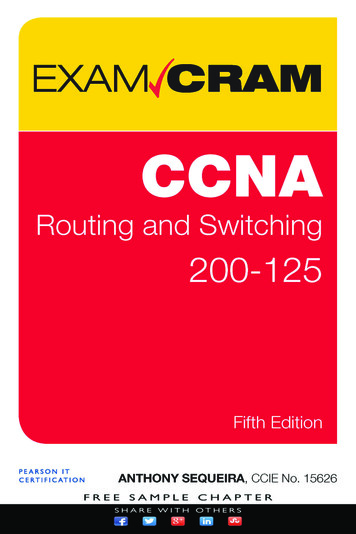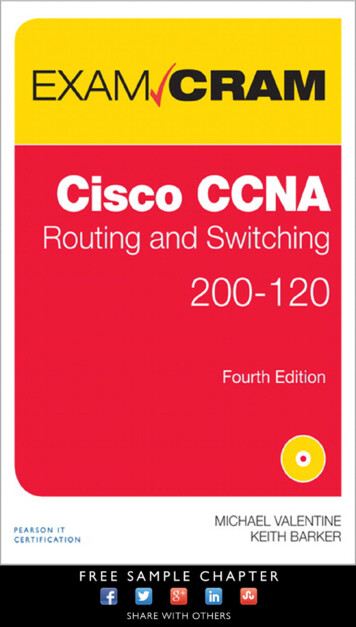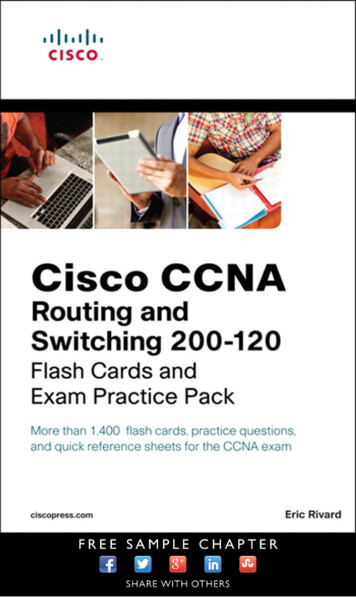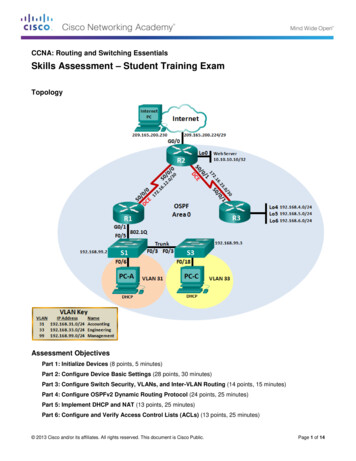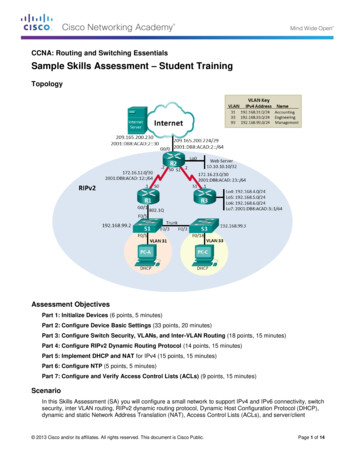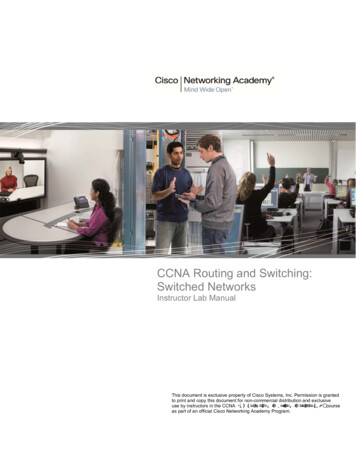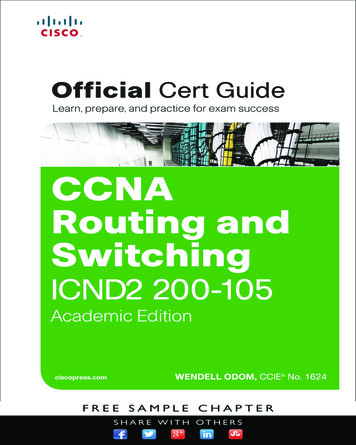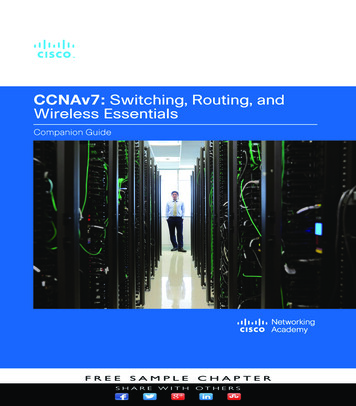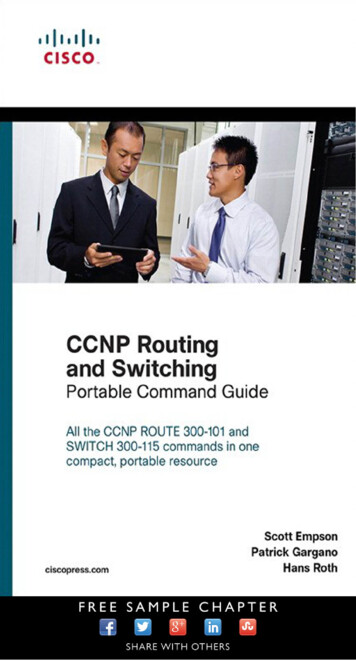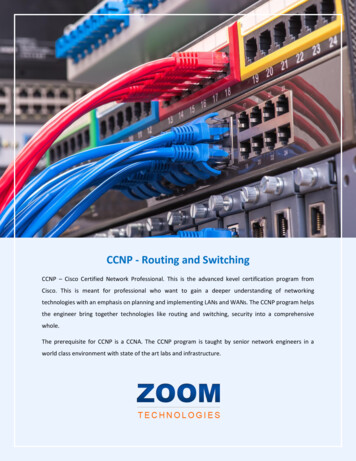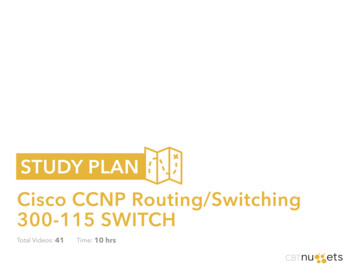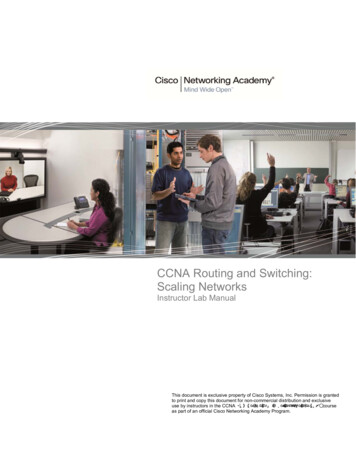
Transcription
CCNA Routing and Switching:Scaling NetworksInstructor Lab ManualThis document is exclusive property of Cisco Systems, Inc. Permission is grantedto print and copy this document for non-commercial distribution and exclusiveuse by instructors in the CCNA 5RXWLQJ DQG 6ZLWFKLQJ 6FDOLQJ 1HWZRUNV courseas part of an official Cisco Networking Academy Program.
Network by Design (Instructor Version)Instructor Note: Red font color or Gray highlights indicate text that appears in the instructor copy only.ObjectiveExplain the need to design a hierarchical network that is scalable.Instructor Note: This activity can be completed by individuals or groups of two students. It can then be shared withanother individual, group, class, or the instructor.ScenarioYour employer is opening a new, branch office.You have been reassigned to the site as the network administrator where your job will be to design and maintainthe new branch network.The network administrators at the other branches used the Cisco three-layer hierarchical model when designingtheir networks. You decide to use the same approach.To get an idea of what using the hierarchical model can do to enhance the design process, you research thetopic.Resources World Wide Web access Word processing softwareDirectionsStep 1: Use the Internet to find information and take notes about the Cisco three-layerhierarchical model. The site should include information about the:a. Access layerb. Distribution layerc.Core layerStep 2: In your research, make sure to include:a. A simple definition of each hierarchical layerb. Three concise facts about each layerc.Network device capabilities needed at each layerd. A detailed graphic that shows a full, three-layer hierarchical model designStep 3: Create a simple table to organize and share your research with another student, group,the class, or instructor.Suggested Activity Example Solution: (information based on The Cisco Three-LayeredHierarchical Model and LAN Design) 2013 Cisco and/or its affiliates. All rights reserved. This document is Cisco Public.Page 1 of 3
Network by DesignAccess LayerDefinitionFactsNetwork DeviceFeaturesThis hierarchical layer connects local clients to the network. It is sometimes called thedesktop layer.At this level: Network equipment works with the distribution and core layers to send andreceive transmissions from clients and users. Collision domains are created using switches. Switches can be configured to filter MAC addresses and share bandwidth. Port security VLANs functionality Fast Ethernet/Gigabit Ethernet transmissions Power over Ethernet (PoE) Link aggregation Quality of service (QoS)Distribution LayerDefinitionFactsNetwork DeviceFeaturesThis hierarchical layer provides policy-based, decision-making network connectivity tothe access layer below it and the core layer above it.At this level: Firewalls and access lists can be placed. Link aggregation can occur. Broadcast and multicast domain boundaries are created. Layer 3 support High forwarding rate Gigabit Ethernet/10 Gigabit Ethernet Redundant components Security policies/access control lists Link aggregation Quality of service (QoS)Core LayerDefinitionFactsThis hierarchical layer is the backbone of the network. It includes high-powered routersand switches that use high-speed cabling, such as fiber optics. The main function of thislayer is reliable delivery of network packets.At this level: All other layers of the hierarchical design model are supported. 2013 Cisco and/or its affiliates. All rights reserved. This document is Cisco Public.Page 2 of 3
Network by DesignNetwork DeviceFeatures Load balancing is desired as an integral service. Efficient, fast, reliable data paths ensure fast network transmissions. Layer 3 support Very high forwarding rate Gigabit Ethernet/10 Gigabit Ethernet Redundant components Link aggregation Quality of service (QoS)Three-LayerHierarchicalDesign GraphicIdentify elements of the model that map to IT-related content: Network design Cisco three-layer hierarchical model Access layer Distribution layer Core layer 2013 Cisco and/or its affiliates. All rights reserved. This document is Cisco Public.Page 3 of 3
Lab – Selecting Switching Hardware (Instructor Version)Instructor Note: Red font color or Gray highlights indicate text that appears in the instructor copy only.ObjectivesPart 1: Explore Cisco Switch ProductsPart 2: Select an Access Layer SwitchPart 3: Select a Distribution/Core Layer SwitchBackground / ScenarioAs a Network Engineer, you are part of a team that selects appropriate devices for your network. You need toconsider the network requirements for the company as they migrate to a converged network. This convergednetwork supports voice over IP (VoIP), video streaming, and expansion of the company to support a largercustomer base.For a small- to medium-sized company, Cisco hierarchical network design suggests only using a two-tier LANdesign. This design consists of an access layer and a collapsed core/distribution layer. Network switchescome in different form factors, and with various features and functions. When selecting a switch, the teammust choose between fixed configuration or modular configuration, and stackable or non-stackable switches.Based on a given set of requirements, you will identify the Cisco switch models and features to support therequirements. The scope of this lab will limit the switch models to campus LAN only.Required ResourcesPC with Internet accessPart 1: Explore Cisco Switch ProductsIn Part 1, you will navigate the Cisco website and explore available switch products.Step 1: Navigate the Cisco website.At www.cisco.com, a list of available products and information about these products is available.a. From the home page, click Products & Services Switches.Step 2: Explore switch products.In the Feature Products section, a list of different categories of switches is displayed. In this lab, you willexplore the campus LAN switches. You can click different links to gather information about the different switchmodels. On this page, the information is organized in different ways. You can view all available switches by 2013 Cisco and/or its affiliates. All rights reserved. This document is Cisco Public.Page 1 of 5
Lab – Selecting Switching Hardwareclicking View All Switches. If you click Compare Series, the switches are organized by types: modular vs.fixed configuration.a. Click the heading Campus LAN – Core and Distribution Switches.List a few models and some of features in the table below.ModelCatalyst 4500-XCatalyst 4500EUplink Speed8 x 10 GE (hotswap module)1G or 10GNumber ofPorts/SpeedOther FeaturesUp to 40 1G/10G portshot swappable powersupplies, cooling fans andnetwork modules, 1 RU,QoS, Fixed configurationUp to 196 1G ports andup to 100 10G portsPoE , hot swappable powersupplies, cooling fans andnetwork modules, Modularconfigurationb. Click the heading Campus LAN – Access Switches.List a few models and some of features in the table below. 2013 Cisco and/or its affiliates. All rights reserved. This document is Cisco Public.Page 2 of 5
Lab – Selecting Switching HardwareModelCatalyst 2960Catalyst 3560-Xand 3750-Xc.Uplink Speed2x1GE uplink4x1GE or 10GEuplink ports(optional)Number ofPorts/SpeedOther Features8, 24, and 48 FE portsPoE , advanced QoS, ratelimiting, ACLs, IPv6,multicast, Fixedconfiguration12, 24, and 48 FE/GEportsQoS, PoE , hot swappablepower supplies, cooling fansand network modules,StackPower and StackWise,Fixed configurationClick the heading Campus LAN – Compact Switches.List a few models and some of features in the table below.ModelCatalyst 3560-CCatalyst 2960-CUplink Speed2x1GE uplink2x1GE uplinkNumber of Ports/SpeedOther Features8-12 FE/GE portsCollocate with users,PoE , Fixed configuration8-12 FE/GE portsCollocate with users, PoE/ PoE pass-through, FixedconfigurationPart 2: Select an Access Layer SwitchThe main function of an access layer switch is to provide network access to end user devices. This switchconnects to the core/distribution layer switches. Access switches are usually located in the intermediatedistribution frame (IDF). An IDF is mainly used for managing and interconnecting the telecommunicationscables between end user devices and a main distribution frame (MDF). There are typically multiple IDFs withuplinks to a single centralized MDF.An access switch should have the following capabilities: low cost per switch port, high port density, scalableuplinks to higher layers, and user access functions and resiliency. In Part 2, you will select an access switchbased on the requirements set by the company. You have reviewed and become familiar with Cisco switchproduct line. 2013 Cisco and/or its affiliates. All rights reserved. This document is Cisco Public.Page 3 of 5
Lab – Selecting Switching Hardwarea. Company A requires a replacement access switch in the wiring closet. The company requires the switchto support VoIP and multicast, accommodate future growth of users and increased bandwidth usage. Theswitch must support a minimum of 35 current users and have a high-speed uplink. List a few of modelsthat meet those requirements.Answers will vary. 2960-S or 3560-X with 48 port capacity and at least two 1G/10G uplinksb. Company B would like to extend services to a conference room on an as-needed basis. The switch will beplaced on the conference room table, and switch security is a priority.Answers will vary. A Compact LAN switch such as the 2960-CPart 3: Select a Distribution/Core Layer SwitchThe distribution/core switch is the backbone of the network for the company. A reliable network core is ofparamount importance for the function of the company. A network backbone switch provides both adequatecapacity for current and future traffic requirements and resilience in the event of failure. They also require highthroughput, high availability, and advanced quality of service (QoS). These switches usually reside in themain wiring closet (MDF) along with high speed servers, routers, and the termination point of your ISP. 2013 Cisco and/or its affiliates. All rights reserved. This document is Cisco Public.Page 4 of 5
Lab – Selecting Switching Hardwarea. Company C will replace a backbone switch in the next budget cycle. The switch must provide redundancyfeatures to minimize possible downtime in the event that an internal component fails. What features canaccommodate these requirements for the replacement switch?Answers will vary. Hotswappable power supplies, cooling fans and network modules, redundant powersupplies, StackWise and StackPowerb. Which Cisco Catalyst switches would you recommend?Answers will vary.3750-X, 4500-X, 4500-Ec.As Company C grows, high speed, such as 10 GB Ethernet, up to 8 uplink ports, and a modularconfiguration for the switch will become necessary. Which switch models would meet the requirement?Answers will vary. 4500, 6500ReflectionWhat other factors should be considered during the selection process aside from network requirements andcosts?Space/form factor, power consumption, modular upgrade, longevity of switch, IOS features for the switch 2013 Cisco and/or its affiliates. All rights reserved. This document is Cisco Public.Page 5 of 5
Layered Network Design Simulation (Instructor Version)Instructor Note: Red font color or Gray highlights indicate text that appears in the instructor copy only.ObjectiveExplain the need to design a hierarchical network that is scalable.Instructor Note: This activity is can be completed by individual students or groups of two students. It can then beshared with another individual, group, class, or the instructor.ScenarioAs the network administrator for a very small network, you want to prepare a simulated-network presentation foryour branch manager to explain how the network currently operates.The small network includes the following equipment: One 2911 series router One 3560 switch One 2960 switch Four user workstations (PCs or laptops) One printerFor further instructions on how to complete this activity, open the accompanying PDF.Resources Packet Tracer softwareDirectionsStep 1: Create a simple network topology using Packet Tracer software. Place the devices atthe appropriate levels of the Cisco three-layer hierarchical model design. Include:a.One 2911 series routerb.One 3560 switchc.One 2960 switchd.Four user workstations (PCs or laptops)e.One printerStep 2: Using Packet Tracer’s drawing tool and indicate the hierarchical layers with differentcolor coding and labels:a.Access Layerb.Distribution Layerc.Core Layer 2014 Cisco and/or its affiliates. All rights reserved. This document is Cisco Public.Page 1 of 5
Layered Network Design SimulationStep 3: Configure the network and user devices. Check for end-to-end connectivity.Step 4: Share your configuration and hierarchical network design Packet Tracer file withanother student, group, the class, or the instructor.Suggested Activity Example Solution:Instructor Note: In the Packet Tracer simulation, a 2911 Series router is used in the Core Layer of thenetwork. Normally, a higher-capacity router, such as the Cisco 3800 series routers, would be used at theCore Layer. Please make students aware of this fact as they work through the activity.2960 Fixed Switch Configuration:Cisco 2960 Switch# show running-configurationversion 12.2no service timestamps log datetime msecno service timestamps debug datetime msecno service password-encryption!hostname "Cisco 2960 Switch"!spanning-tree mode pvst!interface FastEthernet0/1!(output omitted)! 2014 Cisco and/or its affiliates. All rights reserved. This document is Cisco Public.Page 2 of 5
Layered Network Design Simulationinterface GigabitEthernet1/1!interface GigabitEthernet1/2!interface Vlan1ip address 192.168.10.2 255.255.255.0shutdown!ip default-gateway 192.168.10.1!!line con 0!line vty 0 4no loginline vty 5 15no login!!End3560 Switch ConfigurationCisco 3560 Switch# show running-configurationversion 12.2
CCNA Routing and Switching: Scaling Networks Instructor Lab Manual This document is exclusive property of Cisco Systems, Inc. Permission is granted to print and copy this document for non-commercial distribution and exclusive use by instructors in the CCNA 5RXWLQJ DQG 6ZLWFKLQJ 6FDOLQJ 1HWZRUNV course
